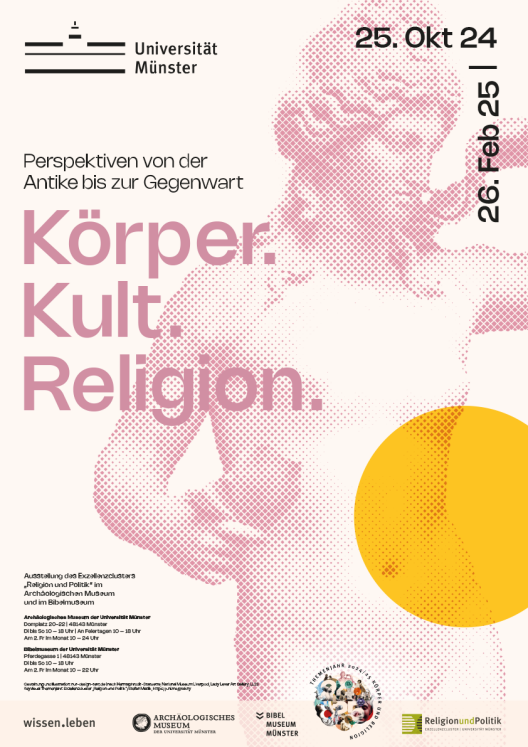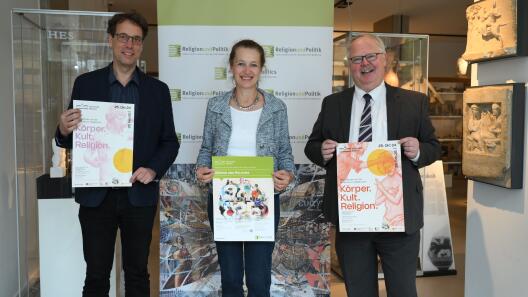Body. Cult. Religion. Perspectives from antiquity to the present
As part of its annual theme “Body and Religion”, the Cluster of Excellence “Religion and Politics” is organizing an exhibition on the body in the world’s religions from antiquity to the present – Opening in the Archaeological Museum and Bible Museum of the University of Münster on 25 October 2024 – Important exhibits on religious practices and ideas from Paris, Vienna and Berlin

Press release from 10 September 2024
The body has always been part of the practices and ideas of the world’s religions. This is shown by the exhibition “Body. Cult. Religion. Perspectives from antiquity to the present”, which the Cluster of Excellence “Religion and Politics” at the University of Münster is organizing in the Archaeological Museum and the Bible Museum at the University from 25 October 2024 to 26 February 2025. “The human body has played an important role in religious practices throughout the ages and across cultures”, explains Egyptologist Angelika Lohwasser, who is organizing the exhibition together with the directors of the museums, archaeologist Achim Lichtenberger and theologian Holger Strutwolf. “Examples include asceticism and fasting, initiation rites and purification rituals, as well as practices involving the dead body. They can already be found in ancient polytheistic religions, and are still visible today in Judaism, Christianity and Islam”. The exhibition features important exhibits from the Louvre in Paris, the Staatliche Museen zu Berlin, the Kunsthistorisches Museum in Vienna, the Fundação Pierre Verger in Salvador, and museums in the region. The objects range from the ancient statuette of the Roman god Hermaphroditus and ritual objects such as a nail fetish from the Congo, to replicas of famous pieces such as the death mask of the Unknown Woman of the Seine, as well as animated and other films about religious clothing.

The exhibition draws on the findings of the Cluster of Excellence’s cross-epochal, interreligious and interdisciplinary research on the relationship between religion and the body. It is part of the Cluster of Excellence’s 2024/25 annual theme “Body and Religion”, which presents current research in an extensive annual programme and provides space for discussion between researchers and the general public. Events planned are a lecture, film and discussion evenings, an opportunity to “walk and talk”, guided tours, a dance workshop, and readings. “The exhibition illustrates the ideas of the annual theme through a variety of exhibits from numerous regions of the world”, says archaeologist Achim Lichtenberger. “It shows how religious traditions shape and influence the human body. The body can serve as a screen for the projection of religious ideas, and be modified through ritual practices, clothing, jewellery and tattoos. Such modifications of the body can serve to achieve spiritual experiences or to signal religious belonging”.
“Divine figures” and “Rituals of life”
The exhibition is divided into seven thematic areas, as theologian Holger Strutwolf explains. The Archaeological Museum is hosting the thematic areas “Divine figures”, “Gender roles?”, “Religion and healing”, and “After death”, which deal with the bodily representation of the divine, the handling of gender roles, religious healing rituals, and the treatment of the dead body in past and present religions. The Bible Museum is hosting “Rituals of life”, “Purity for mind and body”, and “Disembodiment”, these dealing with initiation rituals, purification rites, and the relationship between mind and body in the world’s religions. (fbu/vvm)
exhibition opening
To mark the start of the “Body and Religion” annual theme, the Cluster of Excellence’s exhibition “Body. Cult. Religion. Perspectives from antiquity to the present” will open in the Fürstenberghaus of the University of Münster, Room F2 (Domplatz 20-22, 48143 Münster), on 25 October 2024 at 6 pm. Interested parties are then invited to view the exhibition in the Archaeological Museum and the Bible Museum at the University of Münster.

